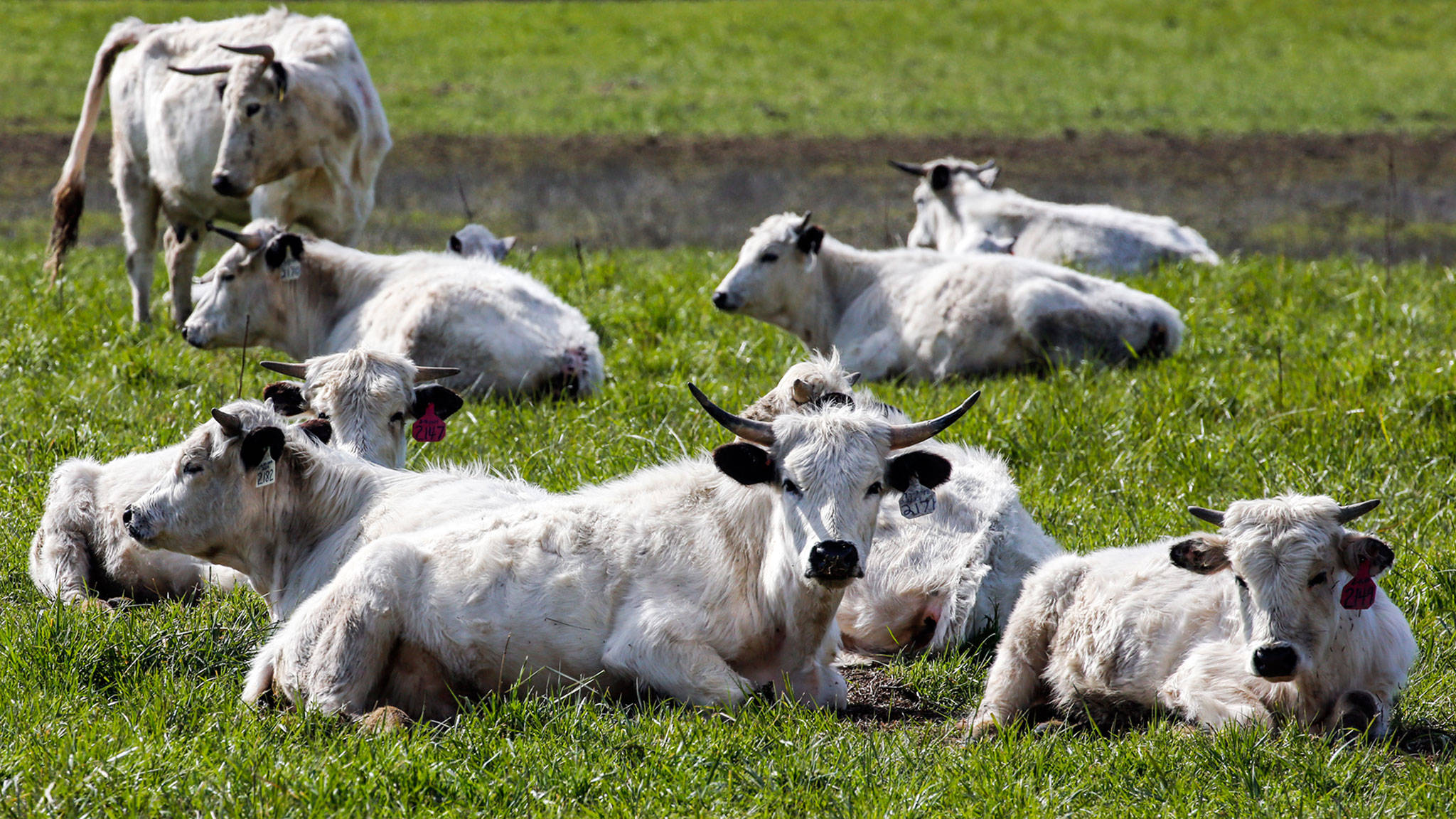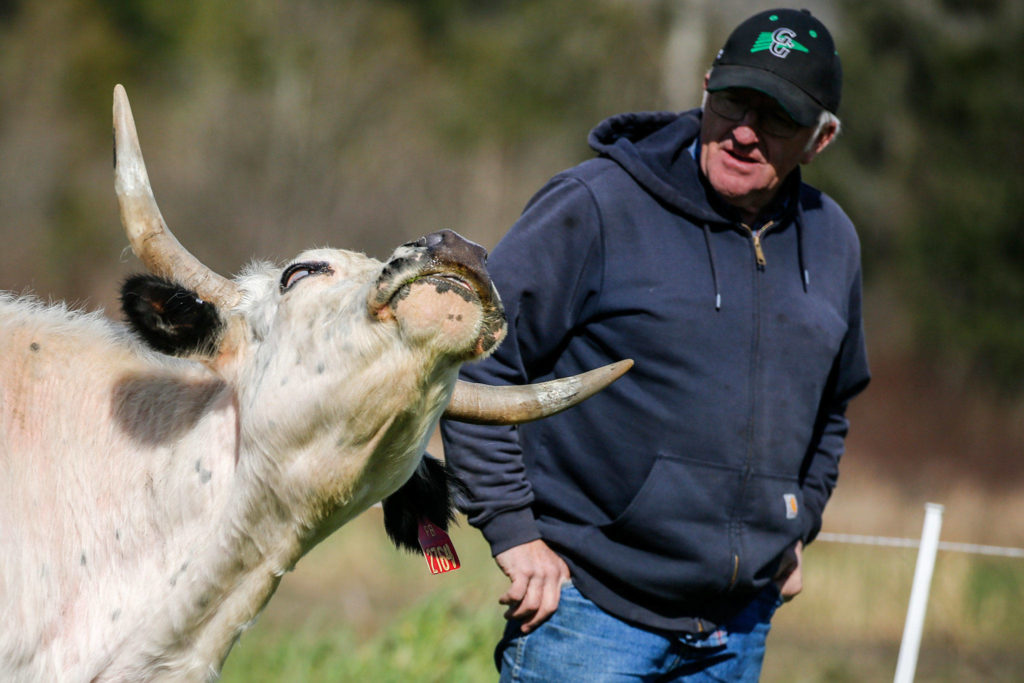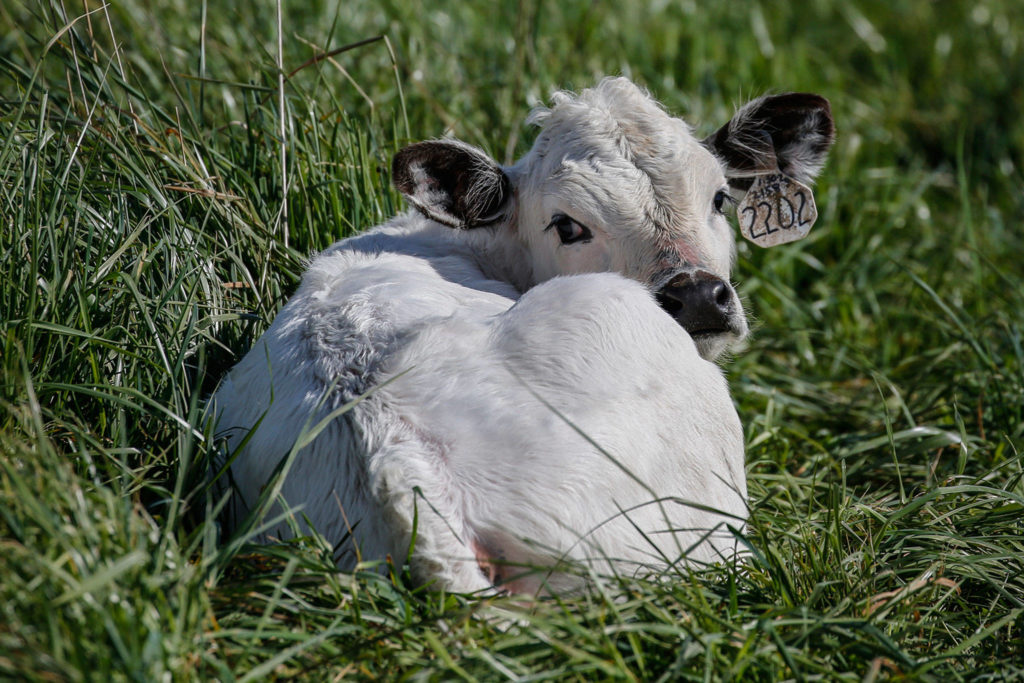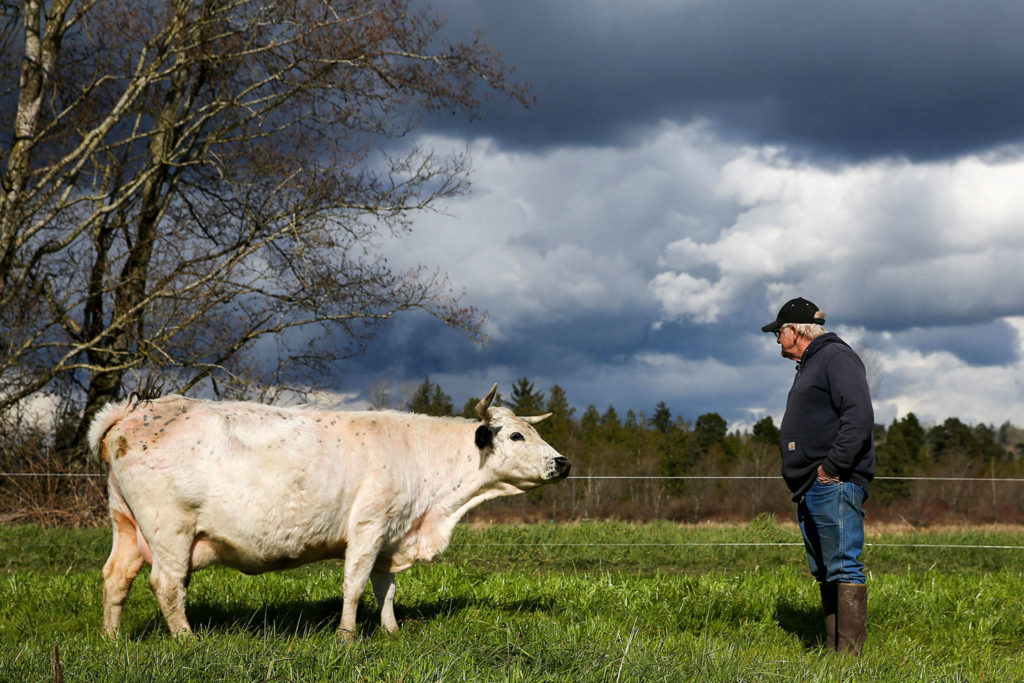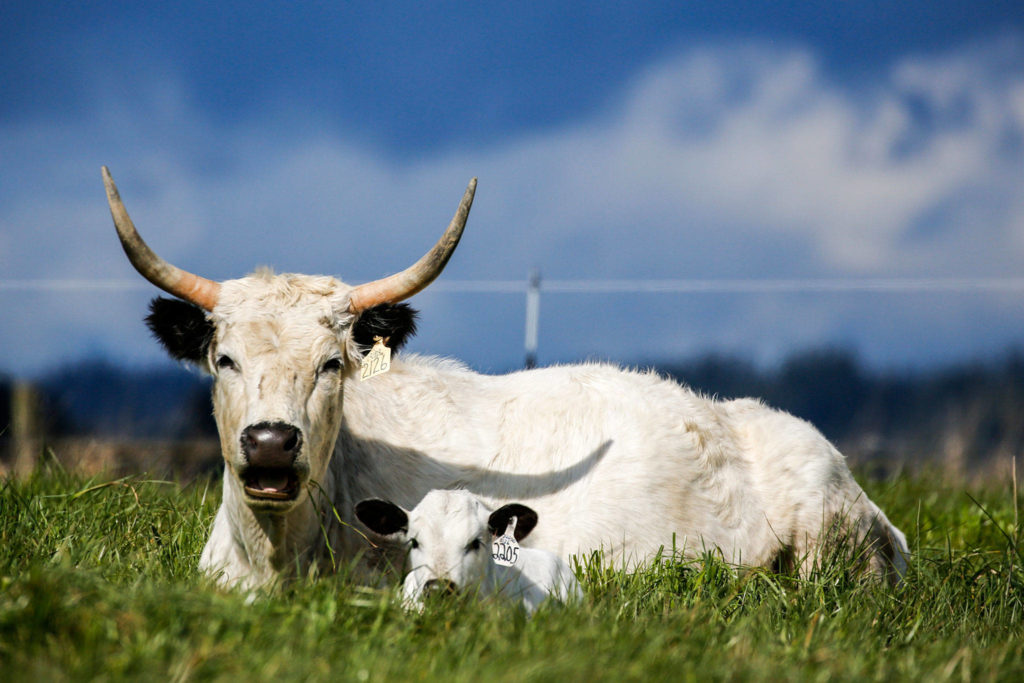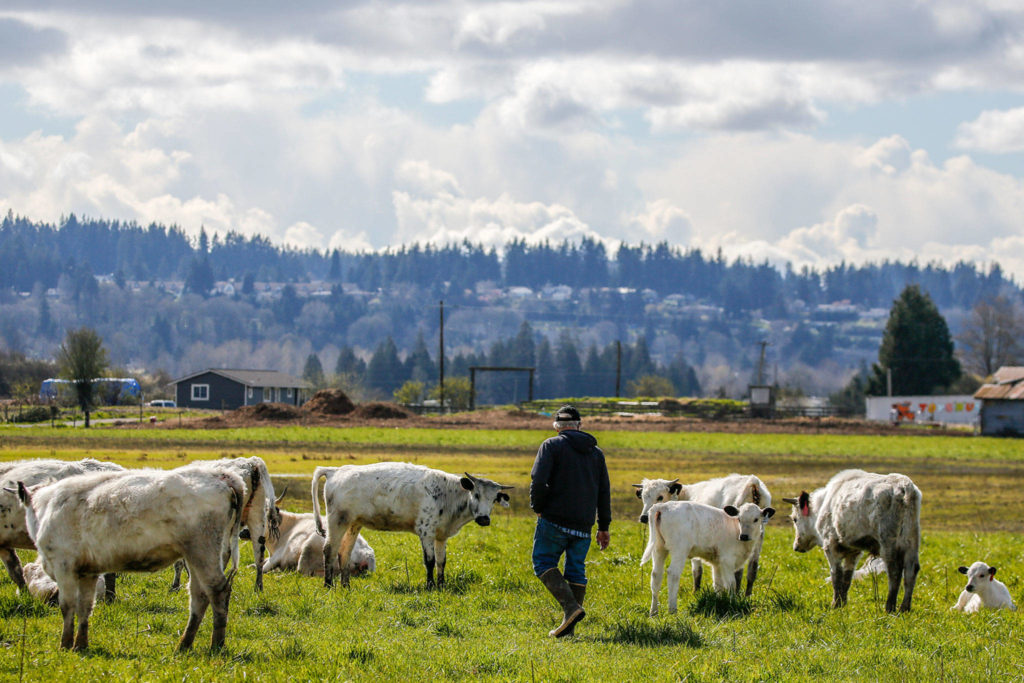When you see Burt DeGroot’s cows for the first time, you might feel like you’re visiting a zoo. You’re not that far off.
DeGroot, of Snohomish, owns a rare breed of cattle. Ancient white park cattle are known for their distinctive appearance and grazing preference.
Like a lone zookeeper, DeGroot, 64, doesn’t have a ranch or any ranch hands. He’s a one-man show. DeGroot loads and separates the horned cattle by himself. Without his own land in Washington, he rents pastures for grazing on Ebey Island, Camano Island and Whidbey Island.
His kids call him the “Cow Whisperer” — but he said that’s just the nature of the breed. They are docile, easy-calving and surefooted.
“They’re the easiest cattle I’ve ever worked with,” he said. “They’re common-sense cattle. They listen like sheep and they follow you.”
In 1989, there were only about 20 purebred cows of breeding age in North America. Now, just 30 years later, there are about 1,300 breeding cows in the U.S. and Canada.
The ancient cattle were listed as threatened by the American Livestock Breeders Conservancy in 2012.
“I guess once you get close to pushing 2,000 of them, they don’t call them ‘endangered,’” DeGroot said, adding that the Livestock Conservancy only counts DNA-tested cattle. “But that can go backwards real quick.”
Ancient white park cattle have been documented in Great Britain since the 13th century. In fact, there are still several herds roaming the British Isles that date from that time. Descriptions of their distinctive white coats and U-shaped horns pop up in historical documents.
Their island-based origin isolated the cattle, therefore making them more genetically distinct than other heritage breeds. The wild cattle had “park” added to their name when they were fenced in, or “emparked,” by Henry III.
A few ancient whites were evacuated to Canada from England just before World War II. Winston Churchill ordered the “national treasures” be sent to North America for safekeeping. Their calves were born at the Toronto Zoo.
Over the years, Churchill’s cattle were moved from Ontario to the Bronx Zoo in New York, and then to King Ranch in Texas, where they were maintained as a closed herd for 40 years.
In the 1980s, the cattle were dispersed to establish several conservation herds in the U.S. and Canada. One of those conservation herds is B Bar Ranch in Montana.
DeGroot purchased 11 ancient white park cattle from B Bar Ranch in Montana in 2013.
With conservation in mind, DeGroot is breeding the cattle to maintain the genetics of the ancient population and increase their numbers.
“I just like history, so I thought I’d get a few of them,” he said. “If I can help bring the breed back, I can not only raise some great beef, but have a story behind it. I thought if I could do something like that, it makes it more worthwhile.”
In 1989, breeders formed the Ancient White Park Cattle Society of North America to monitor the status of the population. These breeders work to conserve some genetic variants that are now rare or have disappeared in the British population.
Members have agreed to reach 200 breeding cows before the cattle could be sold to other breeders. After that, they’re able to sell 10 cows and 1 bull. Which is exactly what DeGroot bought from the ranch in Montana.
DeGroot has been around cattle all his life. He grew up milking cows on his family’s dairy farm in Lynden. Then he moved to Idaho and trimmed dairy cows’ hooves for 12 years. He kept his ancient white park cattle in Idaho for a time. But when he got a job in Snohomish, he took his cows with him.
Since 2013, DeGroot has recorded 117 cow births. He has about 90 cattle in his herd today — four bulls and about 86 cows. About 50 of his cows are due to have calves in April.
His population has multiplied 13 times in eight years. He started with 11 cattle in 2013, counted 38 animals in 2015 and, at his most, he had 143 ancient whites in 2019. “They do multiply very fast,” he said. “They’re like rabbits.”
The breed is identified by its white coat accompanied by colored points — black around their eyes, ears, nose and hooves.
A few of the cattle are born solid black, expressing a recessive gene for color that runs through the population.
DeGroot has three black cattle. “Every one in 12 will be born black,” he said. “But the white is the strongest gene, and so the black ones will end up having all white calves.”
Even rarer in America is another recessive gene that, when expressed, the cattle are born with red-colored points. DeGroot has been trying to breed in the red traits for years. He doesn’t have one yet.
“You might see one in 250 cattle,” DeGroot said. “If I get one, nobody is going to touch it, because it is rare.”
He plans to take some of his cows to B Bar Ranch soon to try once more to breed calves with the coveted “red ears.”
“We’re going to try to get a bull that will throw me some red ones, because they are purdy,” DeGroot said. “It gives you something to talk about.”
Ancient white park cattle also are athletic and lean in appearance. The cows can range in size from 1,000 to 1,200 pounds when mature; the bulls between 1,500 and 1,800 pounds.
The light-colored, black-tipped horns curve out and then up in a U shape. The cows’ horns continue to twist as the animals age, while the bulls have shorter horns that curve forward with age.
The ancient breed should not be confused with the American white park, a polled beef breed developed in the U.S. after World War II, or the polled dual purpose British white.
In addition to raising his own cattle, DeGroot works as a farmhand for Sno-Valley Farms Inc. in Snohomish and sells corn seed as an area manager for Fraser Seeds based in British Columbia.
Don’t ask DeGroot to sell you a purebred cow unless you’re planning to start your own herd. He won’t sell her for the meat nor if you have plans to cross breed her.
“There is very limited supply of these cattle,” he said. “You have to keep in mind that not that long ago they were almost gone.”
As a heritage breed, ancient white park cattle don’t have as many issues as the more common breeds. They don’t have calving problems, they don’t need their hooves trimmed, they don’t escape electric fences and they don’t need to feed as much. What’s more, they don’t need to be sheltered in a barn.
The only drawback he can think of? Ancient whites don’t mature as fast as their commercial counterparts. An angus steer can go to the market in 20 months. An ancient white won’t be ready for another six months. Even then, DeGroot said the marbled meat is worth the wait.
“What can I say? They’re a rare breed,” he said. “They’re a joy. I never thought I’d have animals that were a joy to take care of — not a chore, but a joy.”
DeGroot’s on the look out for more pastures in Snohomish and Island counties to rent so he can expand his herd of ancient whites. As it is now, he doesn’t have the acreage to keep more than 100.
Most herds are kept on pastures 24/7, where they are free to roam and graze, without shelter or supplementary feed. Aggressive grazers, these cattle actually prefer rough terrain — think blackberries and thistles.
“I’ve sold some because I don’t have the space,” he said. “If I had a place to put them, I probably wouldn’t have sold any of them because they’re still on the threatened list.”
Where are his cows? Some of DeGroot’s cattle are at home on Bell’s Farm, a family operation that’s been around since 1946. Most famous for its strawberries, the Coupeville farm also offers pasture-raised lamb, mutton, pork and — more recently — beef.
Owner Kyle Flack found out about DeGroot’s cattle via Craigslist. He was interested in ancient white park cattle for their demeanor and diet. He planned to run cattle and sheep together — meaning they’d graze as a mixed herd. As a bonus, the cattle deter coyote attacks.
“They’re very protective of their young,” DeGroot said of the white cows. “They’ll run a stray dog, deer, coyote off the field.”
Flack, 33, said he wasn’t interested in commercial breeds like black angus. An ornery breed, Flack figured they’d be just as much, if not more, trouble as the coyotes. He was willing to take any heritage breed — after all, the cows he wanted are rare — but he was lucky and got his top pick.
He purchased five cows from DeGroot two years ago, followed by another 20 last year. Bell’s Farm now has 28 cows and 31 ewes. Ever since he purchased the cows, Flack hasn’t had any coyote problems.
“When I had just sheep grazing, I had to really be on guard for coyotes,” Flack said, adding that none of his animals are housed in barns. “But my cows will actually line up and face down any coyotes lurking around the fence. They’re a comfort.”
DeGroot didn’t find out about the breed via Craigslist. He saw an ad for ancient white park cattle in a Seed Savers catalog in 2011. That’s right, Seed Savers Exchange isn’t just about saving seeds.
“I got the Seed Saver magazine and was like, ‘What is this?’ ” DeGroot said. “ ‘I’ve never seen a cow like this before.’ ”
He said that’s the reaction he got when neighbors saw his white cattle grazing on his family’s farm in Lynden. He took them there to give birth in 2013.
“They said, ‘Burt, what is this stuff? What are these cattle? I’ve never seen them before,’ ” DeGroot said. “I said, ‘No you haven’t!’ They said, ‘These cattle look like they came out of a zoo.’ I said, ‘They did come out of the zoo.’ ”
Sara Bruestle: 425-339-3046; sbruestle@
More information
Are you interested in purchasing heritage beef or starting your own herd? Burt DeGroot can be reached at 208-573-5294 or camanograssfedbeef@gmail.com.
Washington North Coast Magazine
This article is featured in the spring issue of Washington North Coast Magazine, a supplement of The Daily Herald. Explore Snohomish and Island counties with each quarterly magazine. Each issue is $3.99. Subscribe to receive all four editions for $14 per year. Call 425-339-3200 or go to www.washingtonnorthcoast.com for more information.
Talk to us
> Give us your news tips.
> Send us a letter to the editor.
> More Herald contact information.
